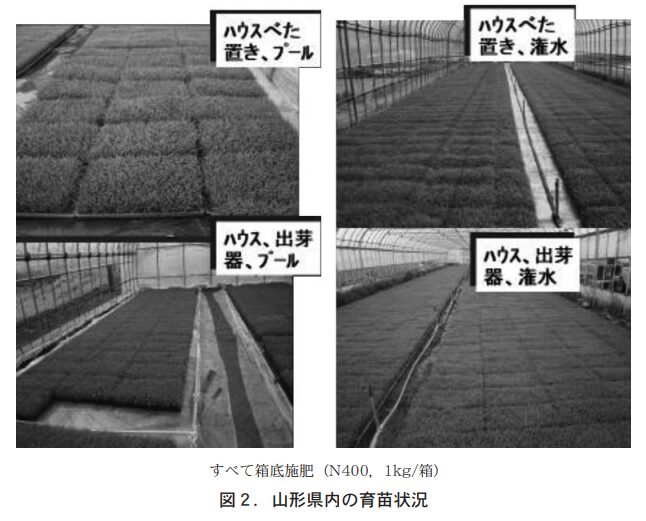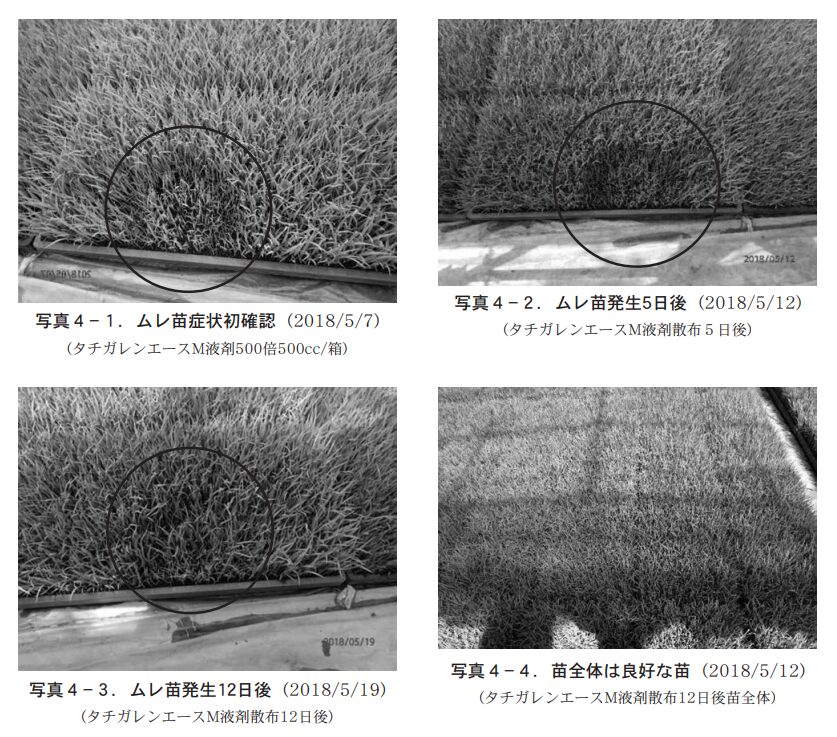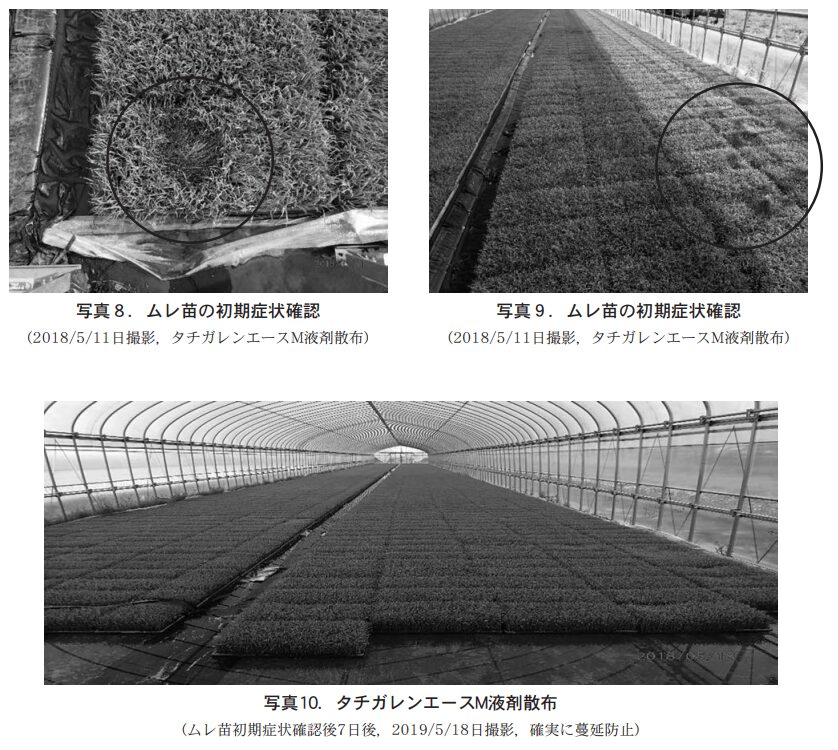

Site Search
Search within product
No. 719 Published 2020 (R02) .04
Click here for PDF version
Agriculture and Science 2020/4



High quality stable production of hard wheat
Development of labor-saving fertilization technology to realize
三重県農業研究所 農産研究課
研 究 員 内 山 裕 介
(現 四日市農林事務所 四日市鈴鹿地域農業改良普及センター 鈴鹿普及課 主任)
Introduction
Mie Prefecture has a wheat crop area of 6,590 ha (2018 crop statistics from the Ministry of Agriculture, Forestry and Fisheries), and four varieties of hard and soft wheat are grown in the prefecture. Demand for prefectural wheat continues to outstrip supply due to strong demand from actual consumers, as evidenced by its use as an ingredient in the local delicacy "Ise Udon," and increased production of both hard and soft wheat varieties is required.
However, as the old saying goes, "wheat is harvested with fertilizer," fertilizer management is the key to wheat cultivation. In particular, the stable production of high-quality hard wheat requires three additional nitrogen fertilizer applications in addition to base fertilizer application, which is very labor intensive. In addition, due to the expansion of the scale of production, there is competition with rice cultivation in the early spring, and quality and yield are often reduced due to the lack of timely fertilizer application in the late growth period. To counter these problems, a labor-saving fertilizer application technology using a fertilizer with controlled fertilizer effect is desired, but until now there has been no fertilizer with controlled fertilizer effect specifically for hard wheat. Therefore, we have studied the development of a labor-saving fertilizer for hard wheat with regulated fertilizer efficacy, with the aim of achieving stable, high-quality production of hard wheat.
Details of the study
(1) Study of labor-saving fertilizer application system
The labor-saving fertilization system shown in Table 1 and the conventional system (three times fertilizer application) were compared in the laboratory (Matsusaka City) and in the field (Tamaki Town) over three years (sown in 2014, 2015, and 2016). For the labor-saving fertilization system, "Wheat Senka 32," a combination of fast-acting fertilizer: linear 20-day type fertilizer (L20) and sigmoid 30-day type fertilizer (S30) in the ratio of 20:40:40%, respectively, was used as the test material. As a test material, "Wheat Senka 32" was used as a reference material, and "Wheat M-Coat 28" was used as a test material, which is a combination of a fast-acting fertilizer: linear 30-day type fertilizer (hereinafter referred to as "L30") and S30 in the ratio of 35:40:25%, respectively (both are Jayca
(Mu Agri Co., Ltd.) was applied in full at a nitrogen rate of 1.6 kg/a at the time of basal fertilizer application.
Hard wheat "Nishino Kaori," which accounts for about 20% of the wheat cultivated area in the prefecture, was used for the study and sown in mid-November (November 7, 2014, December 2, 2015 (re-sown due to rainfall after sowing), and November 18, 2016), which is considered the best time to sow the seeds.
(2) Nitrogen elution pattern of L20 and S30 types
Leaching tests were conducted on the L20 and S30 types used in the labor-saving fertilizer application system by embedding them in the soil.
(Figure 1).
The results showed that fertilizer nitrogen elution of the L20 type was about 701 TP3T from sowing to the ear formation stage. On the other hand, the S30 type started leaching around the time of ear formation, and leached about 201 TP3T by the time of the beginning of leaf extraction, and about 601 TP3T by the time of flowering, and continued leaching thereafter.

(3) Labor-saving fertilizer application system maintained the same level of growth as the conventional system throughout the growing season.
The relationship between fertilizer application and growth is shown in Table 2. From the time of sowing to the beginning of leaf extraction, the labor-saving fertilizer systems ("Wheat Specialty 32" and "Wheat M-Coat 28") showed the same level of growth as the partial fertilizer systems. This also confirmed that nitrogen leaching from the fertilizer regulated fertilizer was sustained, similar to the results of the above-mentioned embedded test.
4) "Wheat Senka 32" improves the quality of hard wheat compared to "Mugi M Coat 28
The relationships among yield, yield components, and protein content are shown in Table 3. In terms of protein content, one criterion for evaluating the quality of hard wheat, "Wheat Senka 32" had higher protein content than "Wheat M Coat 28," which is the same labor-saving fertilizer system, and improved the quality of hard wheat.
This is thought to be due to the fact that "Wheat Senka 32" contains more S30 type nitrogen that is continuously leached out after the flowering period than "Wheat M Coat 28".

(5) Labor-saving fertilization system has the same yield and slightly lower protein content than the conventional partial fertilization system.
The labor-saving fertilizer system resulted in similar yields (top wheat weight) compared to the conventional fertilizer system. In addition, the labor-saving fertilizer system met the standard value for hard wheat protein content (11.5-14.01 TP3T), except for "Wheat Emcote 28" sown in 2015, which had a slightly lower protein content than the conventional partial fertilizer system when the leaf color at ear emergence was low, as in the 2015 and 2016 sowings (Table 3 Table 3).
This was thought to be because labor-saving fertilization systems are affected by temperature and rainfall (Figure 2), and nitrogen leaching from flowering to maturity may be insufficient.

(6) Effects of labor-saving fertilizer application on the field
In recent years, the spread of labor-saving fertilizer application technology has reduced the number of farmers who say that they have missed the right time for fertilizer application. Labor-saving fertilization technology is becoming a "good-luck charm" for farmers that guarantees stable wheat production, and the time and mental leeway afforded by this "good-luck charm" are leading an increasing number of farmers to take initiatives aimed at achieving higher quality and yield.
Thanks to these efforts, the prefecture's wheat crop sown in 2018 achieved the highest unit yield in recent years, and farmers in the field are becoming even more enthusiastic about wheat production. For example, an increasing number of farmers are taking on "things they have wanted to do but have not been able to," such as drainage measures, application of soil fertility materials, and multiple control of red mold.
Thus, labor-saving fertilizer application plays a role not only in wheat production but also in motivating farmers in the field, and is expected to continue to develop in the future.

Pooled seedling cultivation is a perfect match for boxed seedlings.
Jcam Agri Corporation Tohoku Branch
技 術 顧 問 上 野 正 夫
Introduction.
Pool seedling cultivation is a method of seedling cultivation in which the seedling beds are surrounded by wooden frames and covered with plastic to enable waterlogged conditions. This method originated in Miyagi Prefecture, and has come into the limelight as a labor-saving water management method that allows seedlings to be flooded during the latter half of seedling growth, without the need to worry about frequent irrigation, especially after the Golden Week holiday season. The author has had a lot of experience with seedling management using the seedling box-assigned seedling management method, and believes that pooled seedling management is the best method for seedling management using the seedling box-assigned seedling management method. In particular, seedling box-assigned seedling growth may lead to insufficient moisture in the seedlings due to less bed soil than usual. We believe that the key to healthy seedling growth is to maintain the seedlings in a "water-supplied seedling bed" as soon as they are ready to sprout, which is why we promote pool-grown seedlings.
In this section, we will discuss the specific methods. In addition, I would like to point out the importance of spraying Tachigalene Ace M solution as an essential "measure for preventing mulled seedlings" during the Golden Week period.



1. what to do before sowing (salt water selection, disinfection, soaking, sprouting, shade drying)
Salt water sorting is used to select well-developed seeds and to ensure uniform germination. The salt water sorting can remove the fungal seeds and can be used in combination with seed disinfection to increase the effectiveness of seed control. The specific gravity of the brine selection is 1.13 for Uruchi and 1.08 for Mochi. Soaking is performed to supply moisture necessary for germination, and is carried out until the accumulated water temperature reaches 100℃ and the paddy weight increases by 20 to 25%. When the water temperature is 15°C, about 7 days of soaking is required.
Insufficient soaking time will result in uneven germination, so it is important to allow sufficient time for water supply. In particular, soaking should be done in a net bag with plenty of space and shaken every 2 to 3 days to prevent uneven absorption of water. The water temperature should be kept below 15℃ and the water should be changed every 2 to 3 days. After that, the fully soaked paddy should be placed in a "pigeon chest" condition in a rice germinator. The soaking process is important in relation to the seeding process, and care should be taken not to allow the roots to emerge. The seedlings should be dried in the shade one or two days before sowing to prepare them for the sowing operation.
2. be careful with seedling bedding soil
The pH should be 5 to 5.5, and about 2g of each of N, P, and K per box as a fast-acting fertilizer is required. In the case of seedling box-assigned seedling growth, fast-acting fertilizer is also necessary, and 1 g of N, P, and K per box is the appropriate amount, so there is no problem in using conventional seedling bedding soil (because less bedding soil is needed for seedling box-assigned seedling growth). For seedling cover, use granular, fertilizer-free soil. In particular, use granular soil because powdered soil can become muddy and impair germination.
3. seedling growth is based on seed root elongation
The first requirement for a healthy seedling is "mat formation. If the seedlings cannot be planted by a rice transplanter, they cannot be considered healthy. The seedlings should be well rooted, of adequate length (12 to 16 cm), and the N concentration of the seedlings should be about 3.5 to 4.51 TP3T to complete a rolled mat. In addition, it is often observed that lightweight media do not slide well on the seedling feeder of rice transplanters. Please keep in mind that it is necessary to absorb water beforehand.
Naturally, it is important to manage seedlings sufficiently to prevent them from growing too tall. Seedlings tend to grow more easily in the first half of growth than in the second half. Budding length increases easily, and the height of the first and second leaf sheaths also increases quickly, resulting in "short seedlings. In order to produce "Zunguri" seedlings, which are synonymous with healthy seedlings, we need to pay attention to excessive growth in the early stage of growth above all. In particular, bud length should be within 1 cm and leaf sheath height should be as short as possible. Please understand that the risk of overgrowth is much greater than the risk of no budding. In the past, you may have experienced problems with seedlings not growing long enough, but in the age of greenhouse seedling production, there have been few problems with seedlings not growing long enough.
To take it to the extreme, remove the covering material as soon as the buds are about 5 mm in diameter, and pool-grown seedlings should be managed in a "water nursery" condition. Paddy rice is written "water rice. There is absolutely no problem in keeping the seedlings in a water nursery after sprouting. So far, we have been advising to reduce irrigation water and increase soil temperature from germination to greening period. It is true that raising soil temperature helps root growth. However, if the soil temperature does not rise in greenhouse seedlings
The risk of moisture deficiency after the time of budding is much greater than the risk of water deficiency after the time of budding. The risk of insufficient moisture after seedlings are ready to sprout is much greater. In the case of seedlings grown in a seedling box, the lack of water is a problem because of the small amount of soil. Pooled seedling production allows seedlings to maintain a pooled condition in the early stage of seedling establishment. This is the reason why pooled seedlings are compatible with seedlings grown in a seedling box.
We have discussed the importance of rooting. The first thing that is necessary for good rooting is early budding growth. Needless to say, the initial growth of all plants is important. In rice seedling production, the goal is to achieve uniform growth without increasing bud length. Figure 1 shows the importance of self-sprouting roots (seed roots) as the key to seedling development. Rice seedlings depend on endosperm nutrients until the first leaf stage. Therefore, rice seedlings grow normally until the first leaf stage unless there is a serious problem.

However, when the endosperm nutrients run out, the seedlings begin to absorb nutrients and water through their own roots. If these roots do not grow, rice seedling growth will be fatal. Seedlings that are under-irrigated at sowing (water does not reach the bottom of the seedlings and stays only on the surface) will not be able to grow roots and will be unable to pull off the seedlings. This is why it is important to irrigate the seedlings thoroughly at the time of sowing. For seedlings grown in a seedling box, it is most important to manage the seedlings so that there is not a shortage of water when the roots begin to grow. The reason why the author recommends "box-bottom fertilization" is also to consider the surrounding conditions of the seed rice when nadir roots begin to grow. In the "layered fertilization" method, the seed and the box are coexisting. In box-bottom fertilization, the seed is surrounded by soil because the seedling box is at the bottom of the box. This results in a difference in moisture retention. This is the reason why we encourage box-bottom fertilization.
We believe that box-bottom fertilization is superior, especially when irrigated from above. However, this does not mean that layered fertilizer application is to be rejected. If irrigation is done carefully and seedlings are grown in a pool, there is no problem with either layered fertilization or box-bottom fertilization. Again, it is important to keep the seedlings in a "waterlogged nursery" to prevent water shortage from the early stage of germination onward. This is why pooled seedling management is recommended.
Figure 2 shows the situation in Yamagata Prefecture where seedlings are raised in greenhouses. In the greenhouse method, seedlings are irrigated in four different ways: by placing them in a sprouting container, by placing them directly in the greenhouse without sprouting container, and by irrigating the seedlings from the top or by irrigating them in a pool. The amount of fertilizer applied to each seedling box was 1 kg/box of N400-100 in kind. Good seedling growth was achieved in all cases.

4. the occurrence of uneven seedlings
Mushy seedlings are the biggest problem for paddy rice seedlings. Mushy seedlings initially show physiological symptoms, but when Pisum sativum is involved, the disease spreads rapidly and causes seedling dieback. In the field, the problem is rarely observed until Golden Week.
After Golden Week, the seedlings will have two leaves fully developed and three leaves will begin to emerge. In short, the leaf area index reaches its maximum. During this period, temperature fluctuations are likely to occur due to frequent high and low temperatures. In particular, excessive high temperatures and low temperatures can easily lead to saplings that are saprophagous. In short, at this time of the year, the seedlings are in a struggle between the disease and the seedlings. If the seedlings grow too long and soft, they will be susceptible to disease. If the root growth is strong and the seedlings grow into small, slimy seedlings, the disease will be overcome and the seedlings will grow normally.
In the past, when home production of bedding soil was the norm, it was easy to mix in tachigalene powder. However, as the use of purchased soil became more widespread, the application of tachigalene powder was often not done. In this case, it is important not to miss the early symptoms of seedling damping-off, which appear after Golden Week (often in a circular pattern). At that point, immediately spray Tachigaren Ace M solution 500 times, 500 cc/box. Although it will not cure the symptoms of seedlings affected by murage, it will certainly prevent the spread of the disease to the surrounding area. A 500 cc bottle of Tachigaren Ace-M solution costs a little over 3,000 yen. One 500cc bottle of Tachigalene Ace M Liquid is enough to cover 500 seedling boxes. Don't overlook the early symptoms of uneven seedling growth.
5.Spray Tachigalene Ace M solution immediately after the initial symptoms of seedlings with swelling.
Photographs 4-1 to 4-4 show the condition of seedlings after the seedlings were sprayed with Tachigaren Ace-M solution at 500 times, 500 cc/box, immediately after the seedlings became infested with soggy seedlings. Although Tachigalene Ace-M solution did not cure the symptoms of infested seedlings, it completely prevented the infestation of infested seedlings at the time of final rice transplanting.

6. when the initial symptoms of seedlings with murae were identified but no spray of Tachigaren Ace M solution was applied.
The seedlings were sown on 4/21 (covered with perforated polyethylene) and were greening up in the perforated polyethylene on 4/29 due to the significant delay in removing the perforated polyethylene covering. The growth was good, although the plants were growing long. Under these conditions, we observed the initial symptoms of seedlings that were growing unevenly on 5/11. At this point, Tachigalene Ace M solution should have been applied, but was not. The problem is that we did not spray Tachigalene Ace M solution immediately after confirming the early symptoms of purple seedlings (typical circular symptoms of purple seedlings).

7. when Tachigalene Ace M solution is applied immediately after the initial symptoms of seedlings with murae.
The farmer in charge immediately sprayed the seedlings with Tachigaren Ace M solution, 500 times 500 cc/box, which completely prevented the spread of the saplings. The first occurrence of "Mure" seedlings was confirmed on 5/18. The spraying of Tachigaren Ace-M solution 500 times 500 cc/box at the time of the first occurrence of infestation of saplings is very important.



Conclusion
Pooled seedling management has traditionally been used for water management from the 1.5-leaf stage onward and in the mid- to late-season. However, for seedling box-based seedling management, the ability to maintain waterlogged conditions from the early to mid-emergence stage is of utmost importance. As shown in Photos 1 and 2, waterlogging is maintained as soon as seedlings have sprouted to 0.5 cm to 1 cm in length. The waterlogging condition varies depending on the condition of the pool bedding, but it does not matter. After the first leaf stage, the top of the box should remain waterlogged. This will ensure that the seedlings have good mat formation. Pooled seedling production is a perfect match for boxed seedling production.
Next, "soggy seedlings," which have been seen since the Golden Week holiday, are a common problem in seedlings that had never been affected by soggy seedlings before. The first thing to do is to understand the initial state of "soggy seedlings. If you confirm the initial symptoms, spray Tachigaren Ace M liquid 500 times, 500 cc/box immediately. Although the symptomatic seedlings will not be cured, it will certainly prevent the spread of the disease. If you have been suffering from the "damping-off" symptom for the past several years, you should spray Tachigarren Ace-M solution 500 times, 500cc/box as a preventive spray in the latter half of Golden Week to produce healthy seedlings with peace of mind.